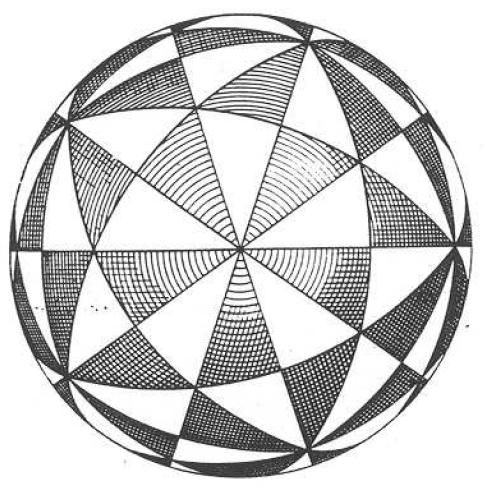A long time ago, I saw an intriguing question posed by Shobhit, asking to show that
\[\begin{align*}\int_0^\alpha \frac{du}{\sqrt{1+u^4}}=\frac{3\Gamma^2\left(\frac{1}{4}\right)}{16\sqrt{\pi}}\tag{1}\end{align*}\]where $\alpha=\sqrt{1+\sqrt{2}+\sqrt{2+2\sqrt{2}}}$. I played with this problem off and on for a few years, but as I was unfamiliar with elliptic curves I did not make much progress on it other than noting it was a rational multiple of
\[\int_0^1\frac{1}{\sqrt{1+u^4}}\,\mathrm du=\frac{\Gamma^2\left(\frac{1}{4}\right)}{8\sqrt{\pi}},\]which I found to be so strange that I thought it could not be a mere coincidence. It turns out that it’s not a coincidence and is really a consequence of
\[\begin{align*}E/\mathbb{C}:\,y^2=x^3-4x\tag{2}\end{align*}\]being an elliptic curve with complex multiplication. Understanding this integral and how to create similar identities was one of my white whales and it feels great to have caught it.
Solution
First we note that $v^2=u^4+1$ has genus $1$ and a rational point $(0,\,1)$, hence it is an elliptic curve. So we may transform the curve
\[E_0/\mathbb{C}:\,v^2=u^4+1\]with the mapping
\[x=\frac{2v+2}{u^2},\,y=\frac{4v+4}{u^3}\]and its inverse $u=2x/y,\,v=-1+2x^3/y^2$ which takes us to the elliptic curve
\[E/\mathbb{C}:\,y^2=x^3-4x\]and back. Details on this mapping and how it generalizes may be seen in Washington, pages 37 and 38.1 This map nets us the equality
\[\begin{align*}\int_0^\alpha \frac{du}{\sqrt{1+u^4}}=\int_{\alpha'}^\infty\frac{\mathrm dx}{\sqrt{x^3-4x}}\tag{3}\end{align*}\]where
\[\alpha'=2\left(1+\sqrt{2}-\sqrt{2+2\sqrt{2}}\right)\left(1+\sqrt{6+4\sqrt{2}+2\sqrt{14+10\sqrt{2}}}\right).\]Things look worse but it actually gets better from here on out. The minimal polynomial of $\alpha’$ ends up being
\[p(x)=x^8-16x^7-48x^6-64x^5+608x^4+256x^3-768x^2+1024x+256\]and running the command E = EllipticCurve('64a1'); E.division_polynomial(8).factor() in Sage shows that $p(x)$ is indeed a factor of the eighth division polynomial $\psi_8(x)$ associated to $E$, hence $\alpha’$ must be the $x$ coordinate of a point of order $8$. It’s easy to see that
and looking at the factors of $\psi_8(x)$ shows, somewhat unsuprisingly, that $x=2$ is also an element of $E[8]$, the order $8$ division points of $E$. This second observation leads us to ask if there is a multiplication by by $n$ map, in the same style as described by pisco2, that turns the point $\alpha’$ into something simple and maps another integral bound in $(4)$ to something that is also easy to deal with. After a lot of pondering, the first canidate that came to mind is applying a $4$-isogeny
\[(x,\,y)\mapsto(f_1(x),\,f_2(x)):\,E\rightarrow E\]to the leftmost integral in $(4)$. The function $f_1(x)$ may be expressed as $f_1(x)=g\circ g(x)$ where $g$ corresponds to the change in $x$ coordinate given by the $2$-isogeny or point doubling formula
\[g(x)=\frac{(3x^2-4)^2 }{4(x^3-4x)}-2x.\]Composing $g$ with itself results in the the rational function
\[f_1(t)=\frac{(256+1280t^2-416t^4+80t^6+t^8)^2}{16t(t^2-4)(4+t^2)^2(16-24t^2+t^4)^2}\]that maps $f_1(2)=\infty$ and $f_1(\alpha’)=2$. This leads us to use the utterly depraved $u$-substitution
\[\int_2^{\alpha'}\frac{\mathrm dx}{\sqrt{x^3-4x}}=-\frac{1}{4}\int_\infty^2\frac{\mathrm dt}{\sqrt{t^3-4t}},\,x=f_1(t)\]which is of the form
\[\begin{align*}4\int_2^{\alpha'} \omega \cong \int_{\infty}^2\omega\tag{5}\end{align*}\]described in the previously referenced math.se page. Using this on the leftmost integral in $(4)$ results in
\[\int_{\alpha'}^\infty\frac{\mathrm dx}{\sqrt{x^3-4x}}=\frac{3}{4}\int_2^\infty\frac{\mathrm dx}{\sqrt{x^3-4x}}.\]The righthand integral in the above equality is very easy to evaluate in terms of the beta function,
\[\begin{align*}\int_2^\infty\frac{\mathrm dx}{\sqrt{x^3-4x}} &= \frac{1}{\sqrt{2}}\int_1^\infty\frac{\mathrm dx}{\sqrt{x^3-x}},\,x\mapsto 2x \\ &=\frac{1}{2\sqrt{2}}\int_0^1 \frac{\mathrm dx}{x^{3/4}(1-x)^{1/2}},\,x\mapsto x^{-1/2} \\ &= \frac{1}{2\sqrt{2}}\text{B}\left(\frac{1}{4},\,\frac{1}{2}\right) \\ &= \frac{\Gamma^2\left(\frac{1}{4}\right)}{4\sqrt{\pi}}. \end{align*}\]Therefore
\[\begin{align*}\int_{\alpha'}^\infty\frac{\mathrm dx}{\sqrt{x^3-4x}}=\frac{3\Gamma^2\left(\frac{1}{4}\right)}{16\sqrt{\pi}}\end{align*}\]and recalling $(3)$ tells us
\[\int_0^\alpha \frac{du}{\sqrt{1+u^4}}=\frac{3\Gamma^2\left(\frac{1}{4}\right)}{16\sqrt{\pi}}\]which is what we had set out to confirm!
The Chowla-Selberg formula
Why is it that any of the above integrals have such nice closed forms in terms of gamma functions at all? Let $\omega_E$ be a non-zero differential for $E$ (an elliptic curve with complex multiplication) over the algebraic numbers and let
\[b_k=\sqrt{\pi}\prod_{a=1}^{d-1}\Gamma^{\frac{w\chi(a)}{4h}}\left(\frac{a}{d}\right)\]where $\chi$ is the Dirichlet character modulo $d$ associated to $k$, $h$ is the class number of $k$, and $w$ is the order of the group of units of $k$. Chowla and Selberg showed that the ratio $\omega_E/b_k$ is always an algebraic number.3 So we see that integrals of the form $\int\omega$ which yield periods of CM elliptic curves are expressable as a quotient of gamma functions times an element of $\bar{\mathbb{Q}}$.
Together with the fact that $n$-isogenies have equivalences of the form given in $(5)$ up to an element of $H_1(E,\mathbb{Z})$ it should be of no suprise that any integral equivalent to a period under some isogeny should be expressable in terms of gamma functions. As a sanity check, the elliptic curve in $(2)$ does indeed have complex multiplication by the maps
\[(x,\,y)\mapsto\left(-x,\,\pm iy\right)\]so the elliptic curve $E_0/\mathbb{C}:\,v^2=u^4+1$ related to $(1)$ also has complex multiplication (following from the maps provided from Washington) and fits this heuristic.
Finding integrals quickly with Sage
Using Sagemath (and on occasion the Chowla-Selberg formula) we can quickly calculate canidate bounds for elliptic integrals. As done before, we can pick a CM elliptic curve by its Cremona label, run the command E = EllipticCurve(<cremona label>), then use E.division_polynomial(n).factor() to produce the $n$th division polynomial to pick possible $x$ values from. Doing so, one can produce a multitude of identitites similar to that which we have already seen.
References
Elliptic Curves, Number Theory, and Cryptography, Lawrence C. Washington ↩
Prove $\int_0^2 \frac{dx}{\sqrt{1+x^3}}=\frac{\Gamma\left(\frac{1}{6}\right)\Gamma\left(\frac{1}{3}\right)}{6\Gamma\left(\frac{1}{2}\right)}$, https://math.stackexchange.com/questions/3781324/prove-int-02-fracdx-sqrt1x3-frac-gamma-left-frac16-right-ga ↩
On the periods of abelian integrals and a formula of Chowla and Selberg, Benedict H. Gross, https://doi.org/10.1007/BF01390273 ↩
